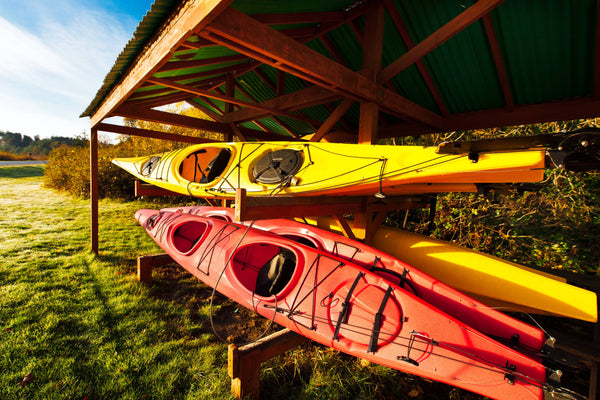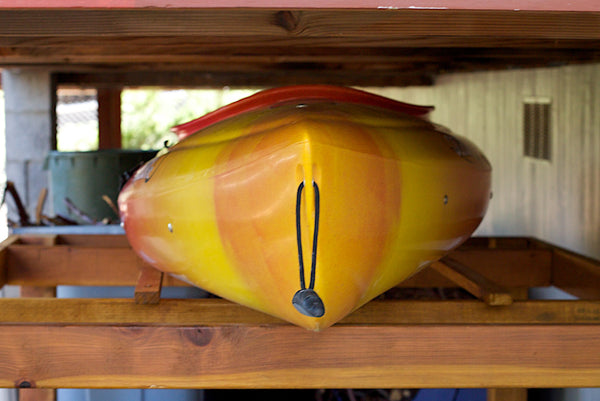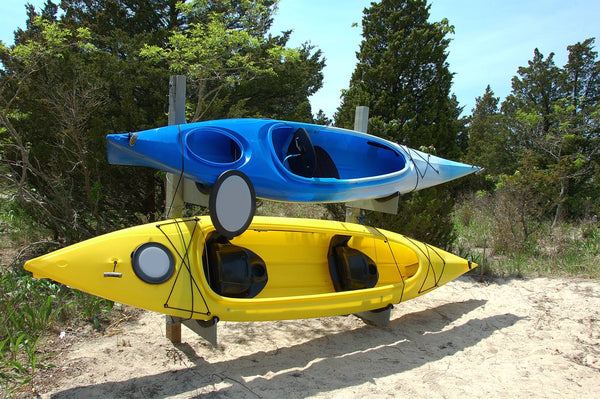How to Store a Kayak
Oct 21, 2019
We have a little mantra here at Bay Sports; ‘take care of your gear and your gear will take care of you’. Buying a kayak of your own is a significant investment and you want to know you are doing the best to take care of your boat so that you can enjoy it for years to come. This guide will take you through the best options for storing your kayak.

Still looking for the perfect kayak for you? Check out our Buyer’s Guide to Choosing a Kayak
Firstly you need to decide whether you will be storing your kayak indoors or outdoors. Many times this decision is made for you by what space you have available. While indoor storage is recommended where possible, this isn’t always an option!
Outdoors
If you are storing your kayak outdoors, take steps to minimise the factors that can cause damage such as light, heat and pressure. You will also need to protect against theft.
Light
Always cover your kayak when storing outdoors. Though most kayaks have UV stabilised protection as standard, long-term storage in direct sun can cause the materials to degrade. A dedicated kayak cover that fits snuggly around your vessel is ideal as this will provide additional protection from dust and dirt.

Invest in a kayak cover to protect your kayak while in storage
Alternatively, covering your kayak with a tarp will suffice. Be sure not to drape the tarp around the kayak as this will trap moisture which will encourage mould to develop. Suspend the tarp over the kayak to provide ample cover from the sunlight.
Heat
Similar to UV damage, direct heat will wreak havoc on your boat, causing it to warp and become brittle. If storing outdoors opt for areas that provide consistent shade such as under a deck.

Avoid storing underneath trees or other shrubbery if you plan on leaving it unattended for long periods of time as falling leaves may gather and rot in your kayak.
Pressure
Never store your kayak directly on a hard surface. Plastic kayaks are particularly prone to developing flat spots and dents when stored on a hard, flat surface for long periods of time. Consider purchasing a dedicated kayak rack, designed to hold your boat off the ground and evenly distribute the weight to prevent warping. If you’re handy you can even construct your own!

Building your own kayak rack is a cost-effective storage solution
Theft
To protect against theft keep your kayak hidden from view and position it in a way that would be difficult for a thief to snatch. Thread a durable cable through a solid part of the boat i.e a moulded handle and secure to a solid point such as a fencepost. If you have a sit-inside kayak, use a steering wheel lock over the cockpit as a further deterrent.
Indoors
There are a range of creative solutions for maximising space in an indoor storage environment. If you are lucky enough to have access to a garage, basement or another storage unit, the advice is similar to outdoor storage. Avoid heat, cover your kayak and store it off the ground.
Suspended Storage
Hanging your kayak is a great way to keep it out of the way. There are many retail products you can purchase that are designed to provide safe and accessible suspended kayak storage. Alternatively, you can customise your own solution. If designing something yourself, be sure to use wide straps to distribute the weight of the kayak evenly.
Choose a strong structure to suspend your kayak from; think a solid wooden beam or sturdy metal pipes. Be sure to position the straps equidistant, approximately one-third of the way along the kayak’s hull. Never hang your kayak from the bow and stern handles as you risk warping the boat.
Rack Storage
As with outdoor storage, there are a range of retail rack solutions you can purchase to store your kayak off the hard ground of your storage area. A “J-Rack” style system will support the kayak evenly while providing easy access should you want to use your boat on a regular basis.

A J-Rack will distribute the weight of your kayak evenly while in storage
Limited Indoor Storage
If your indoor space is limited consider purchasing an inflatable kayak. An inflatable kayak is an excellent alternative to a traditional hard-shell kayak when your storage options are limited. They are 50% lighter than their traditional counterparts and can be packed into a compact bag. After your adventure clean and dry your inflatable kayak before deflating. Once your kayak is deflated, roll loosely and store in a cool, dry area away from direct sunlight.

Preparing your kayak for storage
Whether you store your kayak indoors or outdoors there are a few key steps to take before tucking your kayak in.
Firstly make sure your kayak is clean. You will want to remove any salt, sand or other dirt that can degrade the materials of your boat if left to sit. Use a mild, all-purpose cleaner and a soft sponge when wiping down. Be sure to clean the inside as thoroughly as the outside.
Next, remove any bungs, drainage plugs and inspection ports then give any threads and other moving parts a good clean out as well. Rinse thoroughly with fresh water and dry completely with a towel. Be sure not to skip drying your kayak, if there is any moisture you risk mould or mildew growing.
Finally, ensure there is no way for moisture to gather on any covers or tarps. If water gathers it can put undue pressure on the boat which can cause it to deform over time.
Time to take your kayak on your next adventure? Check out our guide on How to Transport a Kayak.

